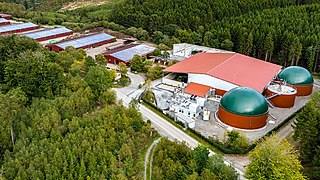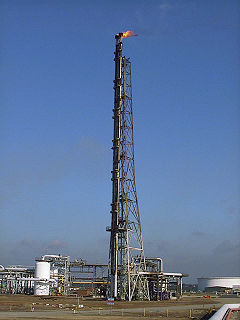
Biogas is a mixture of gases, primarily consisting of methane, carbon dioxide and hydrogen sulphide, produced from raw materials such as agricultural waste, manure, municipal waste, plant material, sewage, green waste and food waste. It is a renewable energy source.

Anaerobic digestion is a sequence of processes by which microorganisms break down biodegradable material in the absence of oxygen. The process is used for industrial or domestic purposes to manage waste or to produce fuels. Much of the fermentation used industrially to produce food and drink products, as well as home fermentation, uses anaerobic digestion.

A gas flare, alternatively known as a flare stack,flare boom, ground flare, or flare pit is a gas combustion device used in industrial plants such as petroleum refineries, chemical plants and natural gas processing plants. They are also common at oil or gas extraction sites having oil wells, gas wells, offshore oil and gas rigs and landfills.
Renewable natural gas (RNG), also known as sustainable natural gas (SNG) or biomethane, is a biogas which has been upgraded to a quality similar to fossil natural gas and having a methane concentration of 90% or greater. By increasing the concentration of methane to a similar level as natural gas, it becomes possible to distribute the gas to customers via the existing gas grid and use in existing appliances. Renewable natural gas is a subset of synthetic natural gas or substitute natural gas (SNG).

The Akshaya Patra Foundation is a non-profit trust of International Society for Krishna Consciousness (ISKCON), Bangalore. It operates Midday Meal Scheme in India.
Gasum Oy is a Finnish state-owned energy company located in Espoo, Finland which imports and sells the nation's natural gas. Gasum owns 17 biogas refineries in Finland and Sweden, and is the largest processor of biodegradable waste in the Nordic countries. In addition, Gasum sells wind power and provides various energy market services. It is in the process of building a gas filling station network that will also serve heavy-duty vehicles.

The Ministry of New and Renewable Energy (MNRE) is a ministry of the Government of India, headed by current Union Cabinet Minister Raj Kumar Singh, that is mainly responsible for research and development, intellectual property protection, and international cooperation, promotion, and coordination in renewable energy sources such as wind power, small hydro, biogas, and solar power.

Biofuels are renewable fuels that are produced by living organisms (biomass). Biofuels can be solid, gaseous or liquid, which comes in two forms: ethanol and biodiesel and often replace fossil fuels. Many countries now use biofuels as energy sources, including Sweden. Sweden has one of the highest usages of biofuel in all of Europe, at 32%, primarily due to the widespread commitment to E85, bioheating and bioelectricity.

Snam S.p.A. is an Italian energy infrastructure company. As of 31 December 2019, it had a market capitalization of €15.4 billion. Snam was originally a subsidiary of Italian energy company Eni. It has since become an independent company, whose largest shareholder is CDP Reti, a holding company controlled by the Italian state. The utility operates in Italy and, through associated companies, in Albania (AGSCo), Austria, China, France (Terēga), Greece (DESFA), the UAE and the United Kingdom. It is one of the main shareholders of the Trans Adriatic Pipeline (TAP). Snam is the main Italian operator for the transport and dispatching of natural gas in Italy, having almost all the transport infrastructures in Italy, with 32,727 km of gas pipelines in operation in high and medium pressure and over 41,000 km including international activities. First in Europe for natural gas storage capacity, the company is also one of the main continental operators in regasification for a total pro quota capacity of approximately 8.5 billion cubic meters per year. Snam is one of Europe's main regulated gas companies - leading Italy in gas transport and storage, while ranking third in regasification. Snam also aims to invest in new energy transition businesses to reduce environmental impact and decarbonisation: sustainable mobility, energy efficiency, renewable gases such as biomethane and hydrogen. The company is listed on the FTSE MIB index of the Borsa Italiana since 6 December 2001.

Bi-fuel vehicles are vehicles with multifuel engines capable of running on two fuels. The two fuels are stored in separate tanks and the engine is able to run on one fuel at a time. On internal combustion engines, a bi-fuel engine typically burns gasoline and a volatile alternate fuel such as natural gas (CNG), LPG, or hydrogen. Bi-fuel vehicles have the capability to switch back and forth from the gasoline to the other fuel, manually or automatically. A related concept is the duel-fuel vehicle which must burn both fuels in combination. Diesel engines converted to use gaseous fuels fall into this class due to the different ignition system.
A biogas upgrader is a facility that is used to concentrate the methane in biogas to natural gas standards. The system removes carbon dioxide, hydrogen sulphide, water and contaminants from the biogas. One technique for doing this uses amine gas treating. This purified biogas is also called biomethane. It can be used interchangeably with natural gas.

India is world's 3rd largest consumer of electricity and world's 3rd largest renewable energy producer with 38% of energy capacity installed in the year 2020 coming from renewable sources. Ernst & Young's (EY) 2021 Renewable Energy Country Attractiveness Index (RECAI) ranked India 3rd behind USA and China. In November 2021, India had a renewable energy capacity of 150 GW consisting of solar, wind, small hydro power, bio-mass, large hydro, and nuclear. India has committed for a goal of 450 GW renewable energy capacity by 2030.

Yeo Bee Yin is a Malaysian politician from the Democratic Action Party (DAP), a component party of the Pakatan Harapan (PH) opposition coalition. She served as the Minister of Energy, Science, Technology, Environment and Climate Change in the PH administration under former Prime Minister Mahathir Mohamad from July 2018 to the collapse of the PH administration in February 2020. She has served as the Member of Parliament (MP) for Bakri since May 2018. She also served as Member of the Selangor State Legislative Assembly (MLA) for Damansara Utama from May 2013 to May 2018. She served as Assistant National Publicity Secretary of DAP from November 2017 to March 2022.

Renewable energy in Afghanistan includes biomass, hydropower, solar, and wind power. Afghanistan is a landlocked country surrounded by five other countries. With a population of less than 35 million people, it is one of the lowest energy consuming countries in relation to a global standing. It holds a spot as one of the countries with a smaller ecological footprint. Hydropower is currently the main source of renewable energy due to Afghanistan's geographical location. Its large mountainous environment facilitates the siting of hydroelectric dams and other facets of hydro energy.
Renewable energy in Bhutan is the use of renewable energy for electricity generation in Bhutan. The renewable energy sources include hydropower.

Ministry of Energy, New and Renewable Energy Maharashtra or MAHAURJA is a ministry of Government of Maharashtra. The Ministry is currently headed by Vacant, TBD since 29 June 2022, a Cabinet Minister.

Nepal had a total primary energy supply (TPES) of 10.29 Mtoe in 2012. Electricity consumption was 3.57 TWh. Most of this primary energy represents solid biofuels used in the residential sector . About 23% of the electricity is imported, with the rest almost completely supplied by hydroelectricity. Nepal also exports hydroelectricity to India in the wet season.
Lusakert Biogas Plant (LBP) is a biogas plant in Nor Geghi, about 26 kilometres (16 mi) north of Yerevan, Armenia. It generates electricity by combustion of biogas produced from animal manure of the Lusakert Pedigree Poultry Plant. The LBP started its operations in October 2008.
Denmark is a leading country in wind energy production and wind turbine production. Wind power alone produced 47% of Denmark's electricity consumption in 2017, and is expected to increase its production by nearly 80% in the years to 2024.
There is enormous potential for renewable energy in Kazakhstan, particularly from wind and small hydropower plants. The Republic of Kazakhstan has the potential to generate 10 times as much power as it currently needs from wind energy alone. But renewable energy accounts for just 0.6 percent of all power installations. Of that, 95 percent comes from small hydropower projects. The main barriers to investment in renewable energy are relatively high financing costs and an absence of uniform feed-in tariffs for electricity from renewable sources. The amount and duration of renewable energy feed-in tariffs are separately evaluated for each project, based on feasibility studies and project-specific generation costs. Power from wind, solar, biomass and water up to 35 MW, plus geothermal sources, are eligible for the tariff and transmission companies are required to purchase the energy of renewable energy producers. An amendment that introduces and clarifies technology-specific tariffs is now being prepared. It is expected to be adopted by Parliament by the end of 2014. In addition, the World Bank's Ease of Doing Business indicator shows the country to be relatively investor-friendly, ranking it in 10th position for investor protection.












